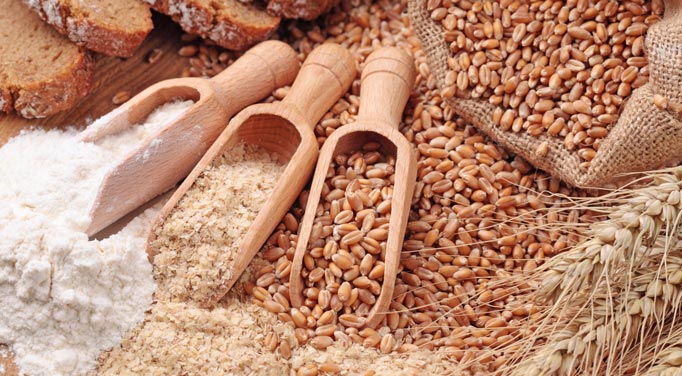 Imagine you are strolling through the grocery store. On your list: bread, pasta, sugar, rice, and eggs. There are so many options for each, especially when it comes to color. Is the brown pasta and bread better? If something is white, am I still getting some nutritional benefit? Here we examine the differences between brown and white color with the foods above, and which provide the most unrefined carbohydrates – the more natural choice.
Imagine you are strolling through the grocery store. On your list: bread, pasta, sugar, rice, and eggs. There are so many options for each, especially when it comes to color. Is the brown pasta and bread better? If something is white, am I still getting some nutritional benefit? Here we examine the differences between brown and white color with the foods above, and which provide the most unrefined carbohydrates – the more natural choice.
Carbohydrates provide fuel to the body. They are the main source of energy for all cellular and metabolic processes. Unrefined carbohydrates are simply carbohydrates that are unprocessed, meaning that the most nutritionally beneficial parts are left intact. For example, whole grain food consists of three layers: the outer shell (called the bran), endosperm, and wheat germ. Unrefined carbohydrates are foods that are minimally processed and keep the food closest to its original and natural state. Unrefined carbohydrates, like whole grains, have been proven to lower risk of cardiovascular disease, weight gain, and type two diabetes according to a 2012 study in the The Journal of Nutrition.
White bread is a carbohydrate from a refined source and undergoes more processing than a whole-grain bread alternative. Bread that is brown in color usually represents whole-grain bread, or bread that still contains the three layers mentioned previously. The three layers that comprise whole grains offer more fiber, phytonutrients, vitamins (13 to be exact), and minerals.
According to the Whole Grains Council Organization, some benefits to eating whole grains include reduced risk for:
Some other benefits include a healthier blood pressure, arteries, teeth, gums, and more. Unrefined carbohydrates from whole grains, as found by The Journal of Nutrition, lower the risk for several serious and chronic diseases like diabetes, heart disease, and cancer. They also aid in weight management, as well as stomach and/or intestinal health.
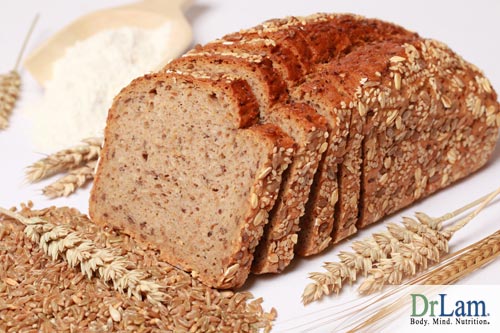 It is worth noting that the fiber from carbohydrate sources like whole and unrefined grains as opposed to refined grains have been found to lower mortality rates for all causes in older women according to a 2000 study. For these reasons, brown bread typically offers more nutrients than its white counterpart. Types of this brown bread that are good to look for include 12-grain, sprouted-grain, whole-wheat and/or whole-grain breads. Even though brown bread is usually more nutrient-dense than white, it’s important not to purchase based on color alone. Check the nutrition label and front packaging for words such as whole-grain or whole-wheat and for fiber content. If the food label does not mention these words, or whole grain flour, it could be processed. Although white breads undergo more processing and are therefore more refined carbs, some of the nutrients are added back into the product using enriched flour. So, even though enriched breads do not offer as many Unrefined carbohydrates as brown breads, it does not mean they are completely lacking in nutrients.
It is worth noting that the fiber from carbohydrate sources like whole and unrefined grains as opposed to refined grains have been found to lower mortality rates for all causes in older women according to a 2000 study. For these reasons, brown bread typically offers more nutrients than its white counterpart. Types of this brown bread that are good to look for include 12-grain, sprouted-grain, whole-wheat and/or whole-grain breads. Even though brown bread is usually more nutrient-dense than white, it’s important not to purchase based on color alone. Check the nutrition label and front packaging for words such as whole-grain or whole-wheat and for fiber content. If the food label does not mention these words, or whole grain flour, it could be processed. Although white breads undergo more processing and are therefore more refined carbs, some of the nutrients are added back into the product using enriched flour. So, even though enriched breads do not offer as many Unrefined carbohydrates as brown breads, it does not mean they are completely lacking in nutrients.
Just like bread, lots of pastas contain unrefined whole-grains and can be identified usually by their brown coloring. These brown, or whole-grain pasta options, have more nutrients and fiber than the more refined white pastas. Since brown pasta offers more fiber, it is actually more filling. Brown rice pasta is another type of brown pasta and it contains not only whole wheat but a blend of ingredients like beans, flax seeds, and lentils. Since brown rice is a blended pasta, it is different from a brown pasta that is made completely from whole-grains. However, it provides a more nutritional alternative to a refined or white pasta.
Sugar in its raw form is brownish in color, has a crunchy and thicker texture, and is free from processing. Brown sugar is processed, or refined, with the addition of molasses – which explains its brown coloring. The U.S. Department of Agriculture (USDA) has found that brown and white sugar have almost exactly the same caloric value, with brown sugar at 17 calories/tsp and white with 16. Although sugars made with molasses may not be the clear winner with regard to caloric intake and unrefined carbohydrates, they do provide antioxidant benefits. In 2009, the Journal of Academy and Nutrition and Dietetics found that dark molasses and blackstrap showed highest levels of antioxidants, followed by intermediate contenders of honey, maple syrup and – you guessed it – brown sugar. Corn syrup, agave nectar, and refined or processed white sugar showed the lowest amounts of these beneficial antioxidants. Raw sugar proved to have a level in between both low and intermediate.
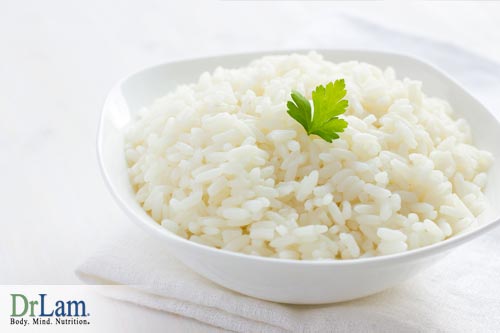 White rice, compared to its brown counterpart, does not have as many phytonutrients – literally plant nutrients. White rice also seemed to raise blood glucose levels faster, which is otherwise coined a high glycemic-index food, compared to brown rice. This may be due to the fact that white rice is more processed and therefore lacks some of the layers of grain, which makes it easier and faster to digest. When the white rice is processed, it loses vitamins, lignans, plant estrogens (phytoestrogens), fiber, minerals like magnesium, and phytic acid, which may all protect against diabetes. This was demonstrated in a 2010 study from the Archives of Internal Medicine that showed participants who consumed more white rice had a higher risk of type two diabetes. Conversely, those who ate more brown rice had a lower risk. When whole grains replaced white rice, risk also decreased.
White rice, compared to its brown counterpart, does not have as many phytonutrients – literally plant nutrients. White rice also seemed to raise blood glucose levels faster, which is otherwise coined a high glycemic-index food, compared to brown rice. This may be due to the fact that white rice is more processed and therefore lacks some of the layers of grain, which makes it easier and faster to digest. When the white rice is processed, it loses vitamins, lignans, plant estrogens (phytoestrogens), fiber, minerals like magnesium, and phytic acid, which may all protect against diabetes. This was demonstrated in a 2010 study from the Archives of Internal Medicine that showed participants who consumed more white rice had a higher risk of type two diabetes. Conversely, those who ate more brown rice had a lower risk. When whole grains replaced white rice, risk also decreased.
The difference between brown and white egg colors mainly stems from the type of care chickens received and what type of chicken produced it. All eggs can have a difference ratio of yolk and white, content of fatty acids, etc. The egg color depends more on things like if the chickens were caged, medicated, what type of diet they were fed, and the brand of egg. An egg contains all the amino acids, making it a complete protein. They provide many nutrients (in addition to the complete collection of amino acids) important in the function of the body, such as vitamin D, calcium, magnesium, potassium, zinc, choline, selenium, iron, and lots of protein. One egg contains six grams of protein according to the USDA. A study found that a higher-protein breakfast, like that of eggs, positively affected hormone, neural, and appetite signals that regulate food consumption.
The adrenal recovery diet recommends quality protein from foods like eggs, since it gives a source of steady energy until the next meal is eaten. Eggs provide vitamin D, which is used in the adrenal fatigue recovery diet to support the synthesis of hormones.
Other beneficial substitutions to refined carbohydrates from grains:
This superfood is a complete protein, or more simply, it contains all the essential amino acids. Quinoa contains lots of fiber too. A study published in 2009 in Advances in Food and Nutrition Research stated that quinoa is a pseudo-grain, or pseudocereal, that contains extraordinary amounts of nutrients and protein. It’s high content of 15 percent protein pairs seamlessly with amino acids, which allows the nutrients like omega-6 and vitamin E to be more readily absorbed. It contains other vitamins, minerals, antioxidants, and phytochemicals as well. Vitamin E is involved in at least six of the different enzymatic reactions in the adrenal cascade, so quinoa is a great staple for adrenal recovery and optimal adrenal function. Quinoa contains lots of magnesium as well, which has a beneficial effect on blood sugar, blood vessels, energy production, and more.
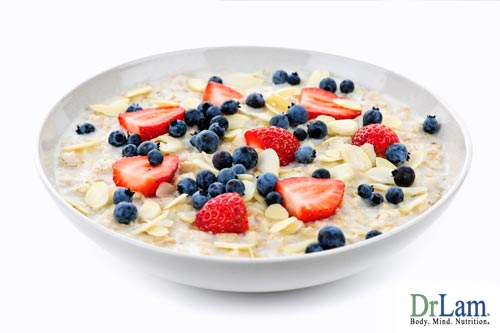 Oats are another unrefined source of carbohydrates that are predominantly known for their ability to lower cholesterol levels, which in turn improves cardiovascular function and health. In fact, a 2001 study published by The Journal of Nutrition found that a hypocaloric diet containing oats dramatically lowered both total and LDL cholesterol as well as systolic blood pressure as opposed to a hypocaloric diet that did not contain oats. This is important because in the early phases of adrenal fatigue, cortisol causes contraction in mid-size arteries and an increase in blood pressure.
Oats are another unrefined source of carbohydrates that are predominantly known for their ability to lower cholesterol levels, which in turn improves cardiovascular function and health. In fact, a 2001 study published by The Journal of Nutrition found that a hypocaloric diet containing oats dramatically lowered both total and LDL cholesterol as well as systolic blood pressure as opposed to a hypocaloric diet that did not contain oats. This is important because in the early phases of adrenal fatigue, cortisol causes contraction in mid-size arteries and an increase in blood pressure.
This amazing food boasts increased levels of phytochemicals and promotes general health. A 2000 study in The Journal of the American College of Nutrition showed that the antioxidants and positively-affected lipoproteins from the phytochemicals helped with colon function and the body’s ability to defend itself from diseases. The USDA states that a cup provides six grams of protein. Millet contains many minerals, such as magnesium. Magnesium is a factor in the development of adrenal fatigue; as it is the most common mineral in the human body. It plays a role in more than 300 enzymatic reactions. Another study in 2009 showed that millet has antioxidant power due to phenolics. When the body is lacking in this mineral, it will suffer on many levels.
As mentioned previously, a higher consumption of whole grains lowered not only weight gain, but also risk for cardiovascular disease and type two diabetes. One of the symptoms of adrenal fatigue is the inclination for weight gain, so eating more of these unrefined-carbohydrate foods may help to reduce excess pounds. Most of those who suffer from adrenal fatigue have several imbalances that can include ones not immediately caught by a medical professional. One such example is insulin resistance. Since eating a diet high in whole-grains lowers the risk for type two diabetes and therefore insulin levels and sensitivity, this is also important to those who suffer from adrenal fatigue. It is known that a poor diet is one of the most important factors and main causes of adrenal fatigue. Foods like brown rice, whole grain bread and pasta, and other unrefined and unprocessed carbohydrate alternatives have a low-glycemic index. This ensures that constant blood sugar levels exist. This is critical to adrenal fatigue recovery. In the adrenal fatigue diet, Dr. Michael Lam advises that 20 percent of the total calories for the day should be from whole or unrefined grains on a rotational basis.
The Neuroendometabolic (NEM) stress response system, or the body’s automatic defense system against stress, accounts for the fact that the body is comprised of several separate functioning organs and systems that all need each other to operate properly. As the body becomes stressed, which can be unavoidable in today’s world, cortisol is one of the hormones released to protect our body. Cortisol is important to the body and adrenal fatigue because it helps maintain normal levels of blood sugar, immune system function, blood vessels, and inflammation.
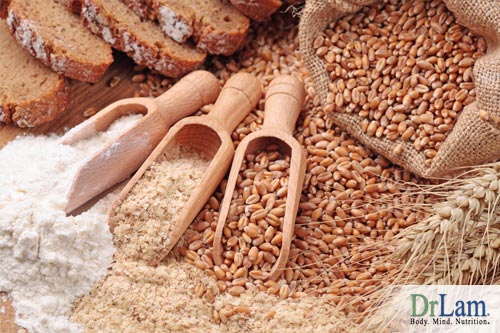 Research completed in 2007 found that whole grain consumption lowered the risk of death due to inflammatory diseases, since whole or unrefined grains inhibit oxidative stress. This is crucial to those who suffer from adrenal fatigue because oxidative damage is controlled when we increase unrefined carbohydrates from grains in our diet, thus preventing inflammation and damage to tissues in the body. The antioxidants provided in most of the foods listed above help prevent the release of cortisol, which will help in adrenal fatigue recovery.
Research completed in 2007 found that whole grain consumption lowered the risk of death due to inflammatory diseases, since whole or unrefined grains inhibit oxidative stress. This is crucial to those who suffer from adrenal fatigue because oxidative damage is controlled when we increase unrefined carbohydrates from grains in our diet, thus preventing inflammation and damage to tissues in the body. The antioxidants provided in most of the foods listed above help prevent the release of cortisol, which will help in adrenal fatigue recovery.
The aforementioned unrefined carbohydrates from grains all serve to better stabilize insulin levels in the body than their refined counterparts. A few hours after a meal, the body begins to become hungry after blood sugar levels drop too low. When blood sugar levels drop, adrenals are activated to produce more cortisol. Cortisol and insulin work together constantly to make sure blood sugar levels are stable. A diet that allows for constant blood sugar levels, or low-glycemic index foods such as the unrefined grains mentioned, is critical to recovery from adrenal fatigue.
A high-quality diet is key to overall health and adrenal fatigue recovery. Eating nutrient-rich foods, such as the unrefined carbohydrates from whole wheat and other grains, will positively affect cardiovascular health, inflammation, insulin levels, weight, hormone level stability, cancer risk, and more. While “brown” foods are not always represented on color alone, they are usually healthier than the white and refined grains. When the body is treated as a machine comprised of several working parts, as seen in the NEM response system, we begin to see that whole-grain and unrefined foods are the best fuel.
© Copyright 2016 Michael Lam, M.D. All Rights Reserved.
